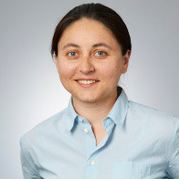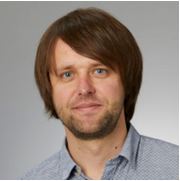Learning sustainability by doing - Collaborative, active and reflexive learning

Kateryna Pereverza and Oleksii Pasichnyi are researchers and teachers at the Department of Sustainable Development, Environmental Science and Engineering (SEED). With a strong interest in teaching, collaborative learning and innovation, they are developing new ways of teaching sustainability inspired by design and real-world issues in close collaboration with students and industry partners. They have presented their concepts at several educational conferences, most recently the KTH SOTL conference.

How are you working with collaborative learning?
“We want the students to learn by doing, and through peer-to-peer-learning. The aim is to truly connect the master’s courses that we teach to our research, and to innovation - and to allow the students to learn from us, external actors, themselves and each other. It’s all about collaborative, active and reflexive learning. The courses are directly related to our own sustainability research and we collaborate with different actors in municipalities and industry. It’s a lot of fun and we are all learning new things every time! I have always been interested in different, innovative ways of teaching and learning. It’s great we have a chance to try them out at our department SEED.” says Kateryna.
At the Urban analytics and transitions (UrbanT) research group, Kateryna, Oleksii and their colleagues have implemented this way of teaching on several different master level courses. The courses are available for master's students in Sustainable technology, KIC InnoEnergy as well as other advanced level students, making for a mixed group of students – international, national, KTH-students and exchange students.
Kateryna explains: “These courses may for many students be the first course with sustainability focus they take, while other students have already completed four or more environmental courses. They all have different starting points, but they can learn a lot from each other and we wanted to find a way to make them all benefit from the course in a more efficient way. The mix of backgrounds and pre-knowledge provide the perfect vibe for collaboration and interchange if encouraged. That’s where collaborative learning really come in.

Oleksii fills in: “In the course Smart Cities and Climate Mitigation Strategies we include many guest lectures on subjects like buildings, energy, sharing economy, data analytics, to allow for a broad view of different issues. The course is project-based with a multidisciplinary approach, including environmental, technological, economic and social aspects. The basic aim of the course is to, on a system level, investigate and explore the potentials of the concept of “Smart Cities” in relation to the challenges associated with mitigation strategies for the cities of today and tomorrow. The students get to complete a “Smart City” team-based project, related to climate mitigation on an urban level. Students often prefer choosing their own project group, so in this course, we provide group rules but free choice within those rules. That way we make sure we get mixed groups. It really allows the students to learn not only from the course, but from each other’s different perspectives and ideas.”
Kateryna continues “I agree, it is important to make sure the project groups are transdisciplinary and heterogeneous. We intentionally mix students from different programmes or subject areas; urban planning, engineering etc. It is very enriching with different backgrounds and the results are often creative. The students advance their ability to learn and adapt, together.”
What kind of projects do they get to work on?
Kateryna continues: “During the course Transdisciplinary Approaches for System Innovations the students get to design and implement a participatory backcasting-based project addressing a real-life complex socio-technical challenge. In the previous year addressed transitions challenges were for example “Sustainable KTH Campus 2050”, “Sustainable city district Hammarby Sjöstad 2050” and "Sustainable urban food production and consumption system in Stockholm by 2050". The project questions are open-ended and sometimes the groups struggle a bit to start. It is common in design and creative subjects with open questions where you make your own interpretation for the final result, but not as usual for more technical subjects. Sometimes it’s an emotional curve to go through - they can feel lost but eventually they solve the puzzle together and understand. It’s great to see when they get it.”
The project topics and issues to be solved often come from suggestions from external partners, like companies and municipalities. Oleksii explains how this provides the students with a learning-by-doing framework.
“To have interdisciplinary projects which often involve external partners makes the project questions much more tangible for the students. The students get to complete their project in close collaboration with a relevant stakeholder such as a waste company, the municipality, or a local energy or water utility. They get to deal with real-life issues, and they get to figure out how to solve them! Some have looked at current energy trends based on real data, some have made working dashboards to show different statistics, it varies a lot what they choose to do. There are some students who find it a bit stressful, they are not used to ‘leaving the box’. They want a more specific task to complete, but engineers need to be able to come up with innovations without a super clear "template". We try to push the students to be more creative in dealing with sustainability issues and solutions, and to be experimental. It’s great to see how they develop during the project! Of course, these are difficult questions and we don’t want the students or our external partners to be disappointed in the end so we make sure they know it is mainly about the effort and learning from experience, not the final result. But sometimes the students do come up with something which can be used in the real-world afterwards. A few years ago in collaboration with Uppsala, one of our project groups made a chat bot which answered questions about a local school and its’ energy usage. They based it on floor plans, data, energy etc. One of the second year students was able to continue develop this in a degree project.”
Kateryna tells more about the course she is involved in: “Last year, the students dealt with mobility and other sustainability questions in close collaboration with the municipality and other stakeholders. The students got to interview municipality representatives, companies, citizens and organise their own study visits to learn about different aspects and views of the issue. Sometimes they have even interviewed random residents in street. It often turns out people care about or are worried about completely different sustainability questions in their everyday life than what the students expected. The problem may have to be framed and re-framed several times after these interviews. Hearing about sustainability issues directly from people involved is often so much more powerful than us teachers saying it! The students really understand when they hear it from others. They learn so much by thinking of the questions relevant to different stakeholders”
How has collaboration worked during the pandemic?
“Of course the fast digitalisation has been a big challenge. Last year, we ran the course physically, mainly in Undervisningshuset, which provides a great environment for collaboration. We truly made active use of the space; re-arranged tables, didn’t allow laptops – just sticky notes, papers, drawings on the whiteboard etc to increase the level of interactions in classroom. And then when the pandemic restrictions started we had to re-design all these collaborative activities to work digitally. We started to think about how we could create a digital space to give the students the same collaborative feel as the year before? We found the platform Miro for collaboration and it’s been great! We have a board shared with all students, different frames for each seminar and a layout for each group. The groups can see what the other groups are doing on the shared space but students also have private spaces for each group. In Zoom when you hold lectures, you can't see if they are listening or understanding but on Miro you can see them being active, taking notes and how they interact. It’s great for both teachers and students. And it provides the course with instant documentation! In previous years, we wanted documentation, but it was more difficult. Now we have a lot of data of what worked well and what didn’t. I am really happy that we found this. It has felt almost as creative as last year!”
Oleksii fills in: My course took place in period 1 in the Autumn so we could do some hybrid teaching. We also used Miro for collaboration, and Slack as well. We were able to have our project meetings live in person. Lecturing works really well digitally, but projects and labs are better live. The risk of disconnection between the teacher and within the group is much higher. We lose the informal and I think we have all realized this year how important that is. That being said, it is very interesting to see how well the students, and teachers, collaborate digitally when we need to. It’s developed the course in new ways!
Lessons in Digital Education
“It’s clear that we cannot take education strategies straight from live to digital without thinking about it, it’s never a copy-paste. As a spin-off from the course, we ran a digital collaboration workshop in May for our students to explore hybrid education and learn from their experiences and perspectives of this last year of digital education. How can we explore the challenges and possibilities together and use the digital tools and technologies in teaching moving forward? It is so important that we learn from this experience and bring the good bits with us.”
Kateryna participated in SoTL conference in March and in the Transformations conferenc e in June and spoke about the Transdisciplinary approaches to systems innovations course and its implementation. “I find it so interesting to study the digitalization of education – for example, how the digital tools impose social pressure which makes many do what others do, or don’t. I have noticed a much lower level of feedback to others this year (last year it was made by putting post-its on a board in front of everyone). It is so interesting to follow this development. It works in ways we don’t fully understand yet.”
Text: Josefin Backman
This is the eleventh article in the School of Architecture and the Built Environment 's new series of articles on selected research, education or collaboration initiatives from each department. You can find the previous articles here:
- KTH Architecture: Introducing Lighting Design Research in Architecture
- Civil and Architectural Engineering: He is planning a new student competition about self-sufficiency
- Real Estate and Construction Management: New forum for discussion and cooperation on housing issues
-
Philosophy and History: The Mediated Planet: Claiming Data for Environmental SDGs
-
Sustainable Development, Environmental Science and Engineering (SEED): Collaborations to understand and manage water
-
Urban Planning and Environment: What makes us decide to change our travel behavior, to opt for innovation and a sustainable future?
-
KTH Architecture: Redesign in focus for a sustainable cultural heritage
-
Civil and Architectural Engineering: Fossil-free steelmaking – large scale storage of hydrogen in rock caverns
-
Real Estate and Construction Management: Collaboration with the City of Stockholm and three-dimensional properties
-
Philosophy and History: Both technology and ethics are needed in the smart city